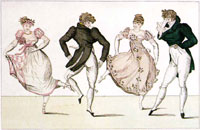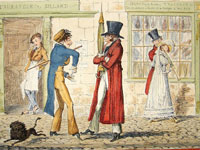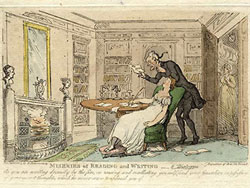Today’s post comes from my bookmarks rather than my library. And, although you can’t really tell from the title of the post, the book in question is a dance manual.
 Among the goodies tucked into the Library of Congress’s online collection is The gentleman & lady’s companion; containing, the newest cotillions and country dances; to which is added, instances of ill manners, to be carefully avoided by youth of both sexes.. This little gem provides instruction (along with suggested music) for most of the dances being done in ballrooms in 1798 – and likely later. I’m sure you’ll find them useful.
Among the goodies tucked into the Library of Congress’s online collection is The gentleman & lady’s companion; containing, the newest cotillions and country dances; to which is added, instances of ill manners, to be carefully avoided by youth of both sexes.. This little gem provides instruction (along with suggested music) for most of the dances being done in ballrooms in 1798 – and likely later. I’m sure you’ll find them useful.
However, the fun part of this treatise comes in the chapter titled “Inftances of ILL MANNERS, to be carefully avoided by youth of both fexes.” I thought it would be fun to consider some of the “inftances.”
Many of these seem pretty much like common sense. For example, “Entering a room with the hat on, and leaving it in the same manner.” This seems like common courtesy even today, particularly in the ballroom. However, “passing between the fire and persons sitting at it,” or “standing between the light and any person wanting it,” is fairly dated advice.
The book advises against contempt in looks, words, or actions, for a partner in dancing, or other persons which makes one wonder why you would request a dance with someone for whom you feel contempt. But perhaps this was more common in 1798. And for heaven’s sake, don’t distort your countenance and practice mimicry. I’m sure there’s no quicker way to lose a dance partner.
By all means, do not “Lean on the shoulder, or chair of another person, and overlooking persons who are writing or reading.” Apparently Caroline Bingley had not read this section or she would not have been overlooking Darcy as he wrote to his sister. Class will out.
You are advised not to “loll on a chair when speaking or when spoken to, and look persons earnestly in the face without any apparent cause.” I can understand the prohibition against lolling. That’s so rarely courteous. But looking persons earnestly in the face? I’m not sure why that’s bad. Any ideas?
 I get “laughing loudly, when in company, and drumming with feet or hands” and “swinging the arms, and all other awkward gestures, especially in the street, and in company.” Even today, I characterize such behavior as “ill-mannered.” On the other hand, “A constant smile or settled frown on the countenance” seems a tad stringent. Yes, a settled frown might be a little off-putting, but don’t you think a cheery face might be okay?
I get “laughing loudly, when in company, and drumming with feet or hands” and “swinging the arms, and all other awkward gestures, especially in the street, and in company.” Even today, I characterize such behavior as “ill-mannered.” On the other hand, “A constant smile or settled frown on the countenance” seems a tad stringent. Yes, a settled frown might be a little off-putting, but don’t you think a cheery face might be okay?
Nevertheless, both the author of The Gentleman and Lady’s Companion and I exhort you to especially eschew “All instances of that ill judged familiarity which breeds contempt.” And have a good day.


Great post as usual, Myretta. As to that bit about “looking people earnestly in the face without any apparent cause”, I think they mean it’s rude to stare. But the way it’s phrased it reminds me of how Mr. Darcy admired Elizabeth’s fine eyes–not so unwelcome!
Another great post, Myretta! And I cannot STAND for people to drum their hands or feet, especially when I am seated at a table with them. GRRRRR !!
Adding this to be TBB list!
You can get this at Amazon, Louisa, but the link will take you right to the online version at the Library of Congress.